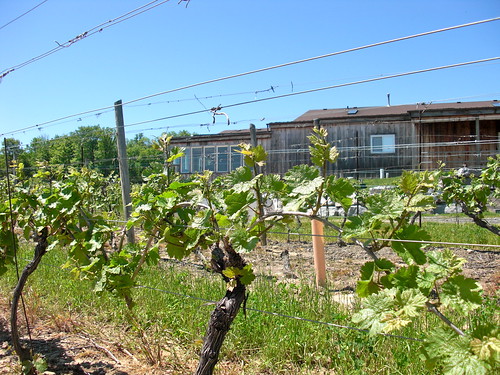
Walking amongst the vineyards that make up The Small Lot Riesling program at Thirty Bench Wine Makers offers no clue as to why the trilogy of wines grown there are so profoundly different, so brilliantly unique that they have evolved into some of the most talked about and collected Rieslings in all of Canada.
The three blocks of Rieslings, that begin with the Wood Post plantings that you can see right out the tasting room window of the Beamsville winery, were all planted within three years of each other (1981 for Triangle, 1982 for Steel Post and 1983 for Wood Post). The grapes, grown in Niagara’s limestone-rich soil, are all picked at the same time and made exactly the same way.
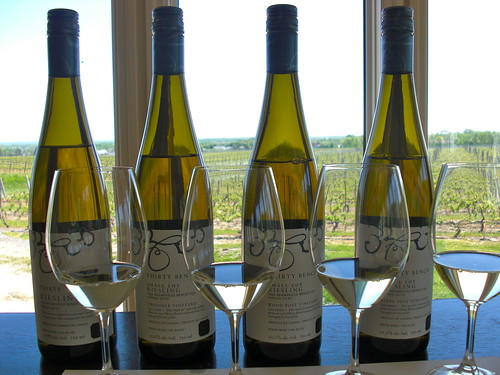
Yet, each bottling is highly distinctive vintage to vintage.
Even the delineation of the three vineyards, somewhat arbitrary back in the day, doesn’t offer up any clues other than the obvious — the Wood Post vineyard is planted using, you guessed it, wood posts; the Steel Post vineyard is planted using steel posts and the Triangle Vineyard is planted in the shape of a triangle. There is no more deep meaning that just that.
All three vineyards in the Beamsville Bench appellation are planted to the Weis 21B clone, the most popular Riesling clone grown in Niagara, with a smattering of the Geisenheim Riesling 356 clone (no more than two acres) sprinkled throughout.
If you ask winemaker Emma Garner what differentiates the three Small Lot Riesling wines, she’ll tell you it simply comes down to vine stress. “The biggest difference is the water retention ability of the soil,” she tells me during a tasting of the 2010 Small Lot Rieslings, which will be officially released at the winery on June 11.
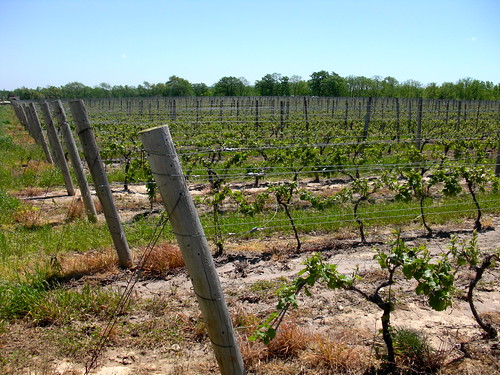
For Riesling, the poorer the water retention, the better the wine. The deeper the roots have to dig into the ground to absorb minerals and nutrients, the Rieslings develop complex flavours and distinctive minerailty, or the terroir of the vineyards.
Garner thinks of her three Rieslings this way:
- Wood Post Vineyard produces citrus-driven, mineral-laden wines.
- Triangle Vineyard is riper, moving into orange-tropical fruit notes with more subtle minerality.
- Steel Post Vineyard is the tightest of the three, restrained, longer aged, and shows profound minerality over time.
The differences are striking and consistent from vintage to vintage.
Each vine is custom grown, hand cropped and thinned and hand sorted to produce very low yields (about 250 cases for each).
In a hot vintage, such as it was in 2010, picking was earlier than other years, in mid-September all within two weeks of each other.
Garner picks grapes based on flavour but was mindful of the lower acids that come with a hot vintage.
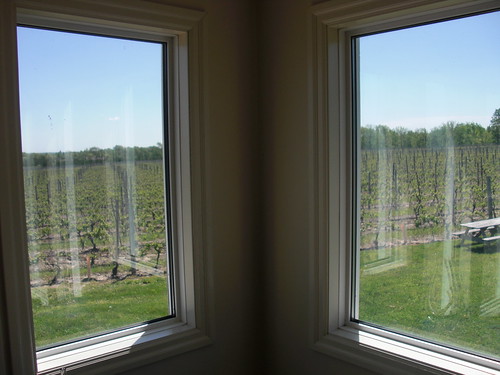
The young vines were picked first as they developed faster than the older vines. And even though Garner separates all pickings — divided by vine age and blocks — and determines which lot goes where (the regular Riesling cuvee or the Small Lot program), grapes from the young vines ended up in the 2010 regular Riesling and the old vines went to the Small Lots.
“In the warmer vintage of 2010, harvesting decisions on Rieslings were imperative. We picked the grapes when they had reached their peak of flavour while maintaining their characteristically crisp acidity said Garner.
“It all comes down to the right picking decisions. You can’t fix that in the winery.” she added.
Overall, the 2010 vintage is fleshier, rounder, more voluptuous and ready to drink upon release but still maintains some fresh acidity, which, is surprising given the extreme heat.
These are fabulous Rieslings to (generally) drink or hold for 3-5 years while you wait on the 2008 and 2009 vintages to come into balance.
Here are my reviews of the three Small Lot Rieslings along with some other wines tasted with Garner.
Note: These wines will be released at the winery on Mountainview Road Saturday and Sunday June 11-12 between 11 a.m. and 5 p.m. Space is very limited so to reserve your tasting glass call 905-563-1698.
Thirty Bench Small Lot Triangle Riesling 2010 ($30, 91 points) — I have to admit, I do like the Rieslings from 2010 for their immediate appeal. But when these ripe wines are made with a decent amount of acidity, such as the Small Lots, I start drooling. The Triangle has a big, ripe fruity nose of floral, peach, grapefruit, tropical fruits and minerals. It is juicy, fleshy, bold and rife with fruits, minerality and moderate acidity. A rewarding wine to try now and for the next couple of years.
Thirty Bench Small Lot Wood Post Riesling 2010 ($30, 92 points) — I admit to being a Wood Post kind of Riesling lover and while I like this wine, it’s not my favourite of the three. Still good, but Steel Post steals the show this vintage. Nonetheless, this is a wet stone mineral-driven beauty with opulent fruits, a dash of ginger and citrus-orange rind aromas on the nose. It feels drier than the other two in the series, even though all three are technically close in residual sugars (pretty much dry). It shows zingy-zesty fruits on the palate, generous fruits and juicy acidity. This will develop in the bottle and those soft petrol notes will come forward.
Thirty Bench Small Lot Steel Post Riesling 2010 ($30, 94 points) — This is what Niagara Riesling is all about for me. The key word is balance and this is perfect in that regard. Steel Post is often the last to evolve, but because 2010 was such a hot vintage, you can see where this is going right out of the gate. An abundance of lime, peach and minerals on the nose. The palate reveals a sensational fruit package of citrus, stone and tropical fruits that come at you in waves with wonderful added wet stone minerality in a balanced approach. This is decadent stuff, and one that will age longer than the other two.
Some other wines we tried:
Thirty Bench Riesling 2010 ($18.50, 88 points) — This is a delicious Riesling in a fleshy style showing flint, citrus and lime on the nose. It’s juicy and round in the mouth and shows length through the finish.
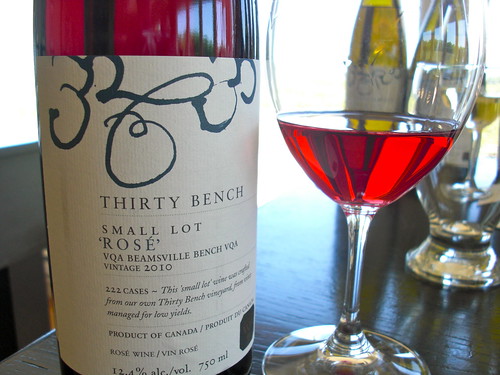
Thirty Bench Small Lot Rose 2010 ($22, 88 points) — A blend of Merlot, Cabernet Sauvignon and Pinot Noir (I kid you not!). As Garner told me: “It’s not one to mess with.” Indeed, an intense nose of bold and meaty red fruits, dare I say “manly” with juicy black cherry and blackberry fruits that carry to the palate. A cold alternative for grilled meats and salads.
Thirty Bench Small Lot Gewurztraminer 2010 ($30, July release, 91 points) — This won’t be released until later on this summer, but, my, what a lavish, exotic treat. This small-production Gewurz, only 132 cases were made, is a low-acid wine with grapes left to hang until mid-October with even some of the fruit developing botrytis. The nose shows poached pear, musk, grapefruit and wild honey, though not finished as a sweet wine. It’s thick and concentrated, like a grand cru Alsatian Gewurz, with layers of complex exotic fruit and spices.
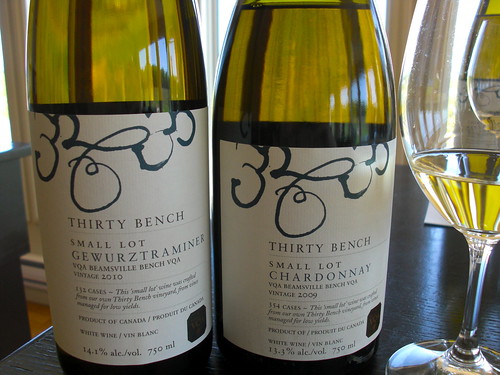
Thirty Bench Small Lot Chardonnay 2009 ($30, 91 points) — Made from vines 12 years old, this Chard gets its matchstick aromas and flavours from the Montrachet yeast Garner likes to use in combination with French oak barrels, with varying toast. The matchstick is the first thing you smell on the nose, with apple, pear and tropical notes followed by spice and minerality. In the mouth, this is a toasty, spicy Chard with rich fruit flavours and a bead of minerality running through the core. All that and a firm acidic backbone. Should age well but hard to resist right now.
Enjoy!






Comment here